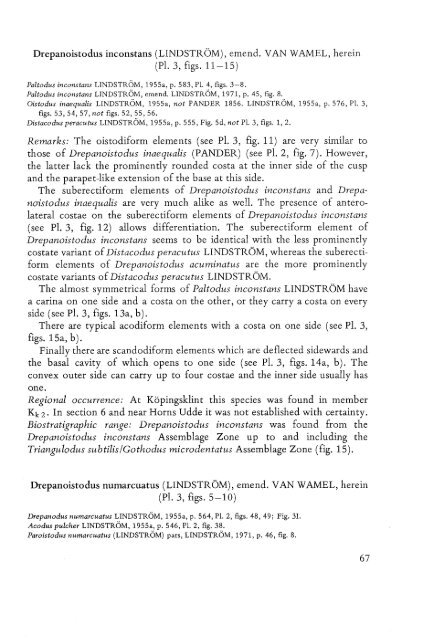UTRECHT MICROPALEONTOLOGICAL BUllETINS
UTRECHT MICROPALEONTOLOGICAL BUllETINS
UTRECHT MICROPALEONTOLOGICAL BUllETINS
You also want an ePaper? Increase the reach of your titles
YUMPU automatically turns print PDFs into web optimized ePapers that Google loves.
Drepanoistodus<br />
inconstans (LINDSTROM), emend. VAN WAMEL, herein<br />
(PI. 3, figs. 11-15)<br />
Paltodus inconstans LINDSTROM, 1955a, p. 583, Pi. 4, figs. 3-8.<br />
Paltodus inconstans LINDSTROM, emend. LINDSTROM, 1971, p. 45, fig. 8.<br />
Oistodus inaequalis LINDSTROM, 1955a, not PANDER 1856. LINDSTROM, 1955a, p. 576, Pi. 3,<br />
figs. 53, 54, 57, not figs. 52, 55, 56.<br />
Dis taco dus peracutus LINDSTROM, 1955a, p. 555, Fig. 5d, not Pi. 3, figs. 1,2.<br />
Remarks: The oistodiform elements (see PI. 3, fig. 11) are very similar to<br />
those of Drepanoistodus inaequalis (PANDER) (see PI. 2, fig. 7). However,<br />
the latter lack the prominently rounded costa at the inner side of the cusp<br />
and the parapet-like extension of the base at this side.<br />
The suberectiform elements of Drepanoistodus inconstans and Drepanoistodus<br />
inaequalis are very much alike as well. The presence of anterolateral<br />
costae on the suberectiform elements of Drepanoistodus inconstans<br />
(see PI. 3, fig. 12) allows differentiation. The suberectiform element of<br />
Drepanoistodus inconstans seems to be identical with the less prominently<br />
costate variant of Distacodus peracutus LINDSTROM, whereas the suberectiform<br />
elements of Drepanoistodus acuminatus are the more prominently<br />
costate variants of Distacodus peracutus LINDSTROM.<br />
The almost symmetrical forms of Paltodus inconstans LINDSTROM have<br />
a carina on one side and a costa on the other, or they carry a costa on every<br />
side (see PI. 3, figs. 13a, b).<br />
There are typical acodiform elements with a costa on one side (see PI. 3,<br />
figs. 15a, b).<br />
Finally there are scandodiform elements which are deflected sidewards and<br />
the basal cavity of which opens to one side (see PI. 3, figs. 14a, b). The<br />
convex outer side can carry up to four costae and the inner side usually has<br />
one.<br />
Regional occurrence: At Kopingsklint this species was found in member<br />
Kk 2. In section 6 and near Horns Udde it was not established with certainty.<br />
Biostratigraphic range: Drepanoistodus inconstans was found from the<br />
Drepanoistodus inconstans Assemblage Zone up to and including the<br />
Triangulodus subtilis/Gothodus microdentatus Assemblage Zone (fig. 15).<br />
Drepanoistodus numarcuatus (LINDSTROM), emend. VAN WAMEL, herein<br />
(PI. 3, figs. 5-10)<br />
Drepanodus numarcuatus LINDSTROM, 1955a, p. 564, Pi. 2, figs. 48, 49; Fig. 31.<br />
Acodus pulcher LINDSTROM, 1955a, p. 546, Pi. 2, fig. 38.<br />
Paroistodus numarcuatus (LINDSTROM) pars, LINDSTROM, 1971, p. 46, fig. 8.
















